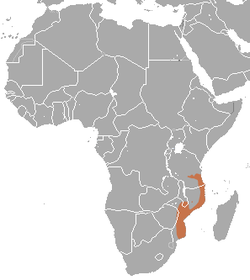| Grant's bushbaby [1] | |
|---|---|
 | |
| Juvenile (approx. 4 months) | |
| Scientific classification | |
| Kingdom: | Animalia |
| Phylum: | Chordata |
| Class: | Mammalia |
| Order: | Primates |
| Suborder: | Strepsirrhini |
| Family: | Galagidae |
| Genus: | Paragalago |
| Species: | P. granti |
| Binomial name | |
| Paragalago granti | |
 | |
| Grant's bushbaby range | |
| Synonyms | |
| |
Grant's bushbaby (Paragalago granti [3] ), also known as Grant's lesser bushbaby or the Mozambique lesser bushbaby, is a species of primate in the family Galagidae. It is found in Malawi, Mozambique, Tanzania, and Zimbabwe. Its natural habitat is subtropical or tropical dry forests. It is a common species and the International Union for Conservation of Nature has assessed its conservation status as being of "least concern". [2]
